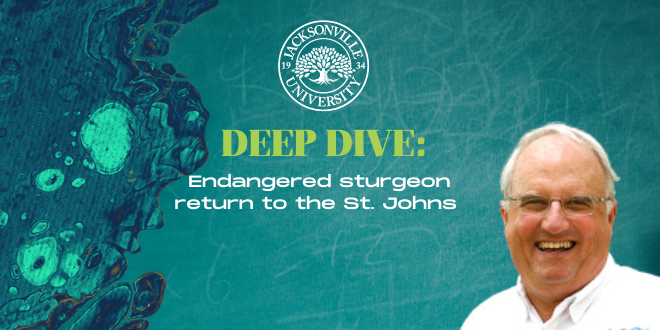Caviar is not something most people think about being harvested from the St. Johns River. Yet, we do have sturgeons who can produce caviar present in the river. Historically, both Atlantic and Shortnose sturgeon were found in the coastal rivers along the east coast from the northern version of the Saint Johns River in New Brunswick, Canada, to our southern version of the St. Johns River in northeast Florida.
However, up until just a few years ago, sturgeons were effectively extinct in the St. Johns River. Sturgeon, once found in great abundance, had seen their populations decline greatly due to overfishing and habitat loss. Sturgeons are prized for their eggs, which are valued as high-quality caviar. Regretfully, to harvest the eggs, the animal has to be killed. That resulted in sturgeon being classified as endangered.
Some good news is that we are seeing some Shortnose sturgeon being found in the area. Most recently, one was found near Reddie Point not far from the Marine Science Research Institute. Florida Fish and Wildlife staff retrieved that carcass to be necropsied to determine the cause of death. A necropsy is the term used to describe the examination of an animal, while autopsy is the term used for humans.
Seven species of sturgeons are found in North America and are thought to be prehistoric, dating back to the time of dinosaurs. Their physical features separate them from other kinds of fish, in that they have scutes, which are large, hard, individual body plates instead of denticles like sharks or scales like other fish have. They appear to be covered in armor.
The Shortnose sturgeon is one of the smallest sturgeons with a maximum body length of four feet and weighing less than 10 pounds. They grow slowly, mature late, and may live over 30 years.
Atlantic and Shortnose sturgeons are benthic or bottom feeders, which means that they feed and forage on creatures on the bottom of the coastal rivers and estuaries. They feed primarily on small mollusks, polychaetes (worms), small crabs, and other crustaceans.
Shortnose sturgeon are classified as anadromous, meaning they live in the estuarine portions of coastal rivers and migrate to freshwater to spawn. They tend to congregate in the main river channels and only use smaller tributaries occasionally. Shortnose sturgeons are rarely found offshore, but they can tolerate full seawater, and do migrate between rivers.
Now that overharvesting has largely been curtailed, some illegal trade does remain. But a significant threat to Shortnose sturgeon survival are the dams located along the Atlantic seaboard that prevent sturgeon from reaching historic spawning areas. Habitat destruction is also a major threat to the sturgeon population. Shortnose sturgeon habitat has increased vulnerability because they inhabit areas that are at risk of dredging. Dredging of rivers also affects the food source of sturgeons as benthic feeders. Other threats to the sturgeon population include lethal by-catch and declining water quality. Water quality and excessive water withdrawals from our rivers are additional threats.
Return of sturgeon to the St Johns River is a positive sign, but we must continue
to take the necessary steps to maintain and improve the water quality and wetland
habitat associated with our waterways.
Glad you asked River Life
What is the difference between fish roe and caviar? Roe is the term used for unfertilized fish eggs. While all fish eggs are technically
“roe,” not all “roe” is caviar. The term caviar only applies to the fish roe in the
sturgeon family that is harvested, and salt cured, typically turning the eggs black.
The bright orange Salmon roe, or ikura, which sits atop sushi, or roe from whitefish,
trout, and other species can be used as “caviar substitutes,” but they are not caviar.



